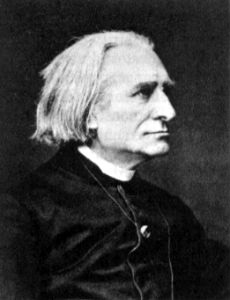
This time, the use of the more serious minor tonality is used as a contrast to the arrival of the playful and jubilant main theme of the Friska. For practical reasons of notation (i.e., the prolongation of the tonic minor key), Liszt chooses the key signature of F-sharp minor, until the arrival of the main theme in F-sharp major. Although the principal key of the Friska is F-sharp major, Liszt chooses to begin in the tonic minor key, F-sharp minor, which is sustained until bar 51. This procedure is directly reversed in the Friska. This device provides a contrast which intensifies the generally dark and sombre character of the lassan. However, by bar 6, the minor tonality is established. Although the lassan's principal key is C-sharp minor (with the appropriate key signature used throughout) the work opens on the tonic major chord, C-sharp major. Liszt planned his choice of keys in a remarkably symmetrical fashion.

Finally, in the key of F-sharp major, there is a crescendo of prestissimo octaves, which ascend and then descend to cover almost the entire range of the keyboard and bringing the Rhapsody to a conclusion. Before the final whirlwind of sound, a moment of calm prevails in the key of F-sharp minor, recalling another of the lassan's themes, and is followed by the instruction, Cadenza ad lib. Modulations are limited almost exclusively to the dominant (C-sharp major) and the lowered mediant ( A major).

At this point, the Friska begins its journey of ever-increasing energy and pianistic bravura, still underpinned by alternating tonic and dominant harmonies. The alternating dominant and tonic harmonies quickly increase in volume, the tempo gaining momentum as the Friska's main theme (in F-sharp major) is approached. It opens quietly in the key of F-sharp minor, but on its dominant chord, C-sharp major, recalling a theme from the lassan. The mood of the lassan is generally dark and melancholic, although it contains some playful and capricious moments. From this point on, the composer modulates freely, particularly to the tonic major and the relative major. Although beginning on the C-sharp major triad, C-sharp minor is soon established as the home key. The first is the lassan, with its brief introduction. The piece consists of two distinct sections. Problems playing these files? See media help. The other themes were taken from the German pianist Heinrich Ehrlich. This theme was found in one of Liszt's Weimar sketchbooks. The title of this rhapsody is slightly misleading, as the introductory theme is Romanian, rather than Hungarian.
Other pianists have arranged their own versions of the Rhapsody with changes beyond that of simply adding a cadenza, most notably Vladimir Horowitz in 1953. Liszt himself wrote several cadenzas for the piece, but they were rarely performed. Marc-André Hamelin composed a cadenza that has since become famous for its originality, musicality and playfulness, and Sergei Rachmaninoff also wrote a famous cadenza for his interpretation. Most unusual in this composition is the composer's invitation for the performer to perform a cadenza, although most pianists choose to decline the invitation.

Offering an outstanding contrast to the serious and dramatic lassan, the following friska holds enormous appeal for audiences, with its simple alternating tonic and dominant harmonization, its energetic, toe-tapping rhythms, and breathtaking "pianistics". In addition to the orchestral version, the composer arranged a piano duet version in 1874, published by Schuberth the following year. Its immediate success and popularity on the concert stage led to an orchestrated version, arranged (together with five other rhapsodies) in 1857–1860 by the composer in collaboration with Franz Doppler, and published by Schuberth in 1874–1875. 2 was first published as a piano solo in 1851 by Senff and Ricordi. Although this prolific composer's works are highly varied in style, a relatively large part of his output is nationalistic in character, the Hungarian Rhapsodies being an ideal example.Ĭomposed in 1847 and dedicated to Count László Teleki, Hungarian Rhapsody No. These elements would eventually play a significant role in Liszt's compositions. The Hungarian-born composer and pianist Franz Liszt was strongly influenced by the music heard in his youth, particularly Hungarian folk music, with its unique gypsy scale, rhythmic spontaneity and direct, seductive expression. ( December 2022) ( Learn how and when to remove this template message) Unsourced material may be challenged and removed. Please help improve this section by adding citations to reliable sources.


 0 kommentar(er)
0 kommentar(er)
